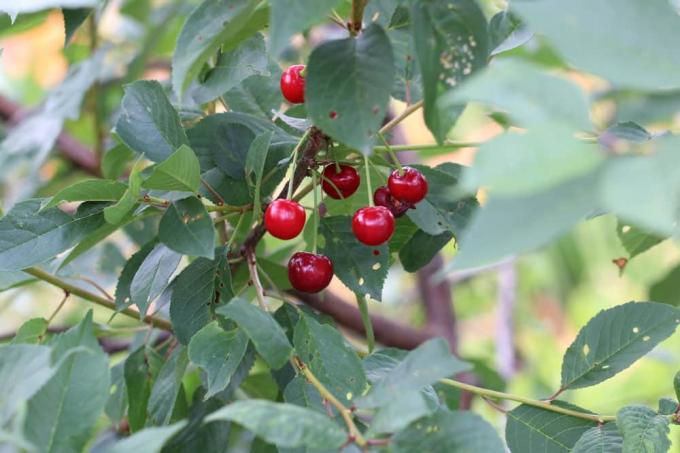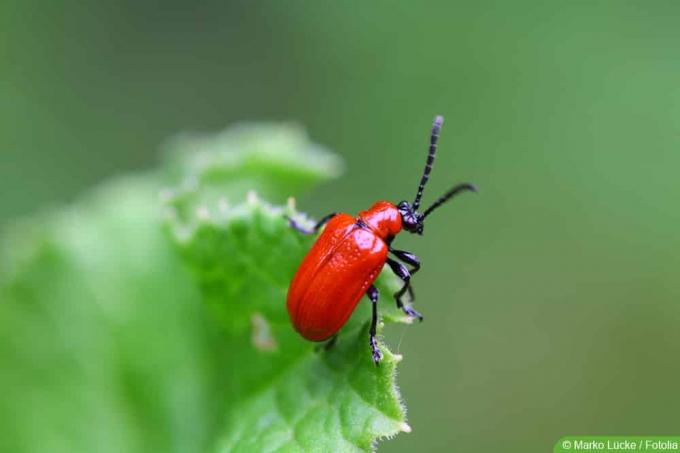

Table of contents
- What does the cherry fruit fly look like?
- How do maggots get into cherries?
- Cover the tree disc with fleece in good time
- Protective nets prevent egg laying
- Yellow panels reduce infestation pressure
- Early varieties are spared
- Beneficial insects – valuable support in combating them
- Biocide - last resort in case of high infestation pressure
When growing sweet cherries in the home garden, controlling the cherry fruit fly has top priority. The native pest infests the ripening fruit with maggots, so that in the worst case the entire harvest is inedible. Home gardeners are not defenseless against the nefarious activities of this borefly species. This guide will familiarize you with ecological control methods for maggot-free cherry enjoyment.
What does the cherry fruit fly look like?
The significant appearance makes it easier for affected home gardeners to reliably identify the cherry fruit fly. The following optical attributes make a Rhagoletis cerasi unmistakable:
- Body markings: shiny black with yellow spots on the thorax and head
- Wings: transparent with blue-black transverse bands
- Body length: 3.5 to 5 mm
- Eyes: green compound eyes
The larvae have a creamy-white body typical of maggots and reach a length of up to 6 mm.
How do maggots get into cherries?
The disaster takes its course from the beginning/middle of May. At this time, the cherry fruit flies hatch after spending the winter under the shelter of the earth. For 8 to 10 days, the borer flies first undergo a maturation feeding on bird excrement or bacterial colonies on cherry tree leaves. When the fruit changes color from green to yellow, the females are ready to lay their eggs. In dry weather and ideal temperatures of 20 degrees Celsius, a single female cherry fruit fly lays 200 to 400 eggs just under the epidermis of the ripening cherries. Since only one egg is laid per cherry, a few flies are enough to destroy the entire harvest.
The larvae hatch within 8 to 10 days and continue to burrow into the flesh. After about 3 weeks of gluttony near the cherry pit, the maggots fall to the ground with the ripe fruit, where they pupate and overwinter. Provided the cherries don't fall to the ground, the maggots rappel down thin threads to get to their winter quarters underground.
Cover the tree disc with fleece in good time

In the first attempt at effective control, the flight of the hatched cherry fruit flies onto the tree should be prevented. For this purpose, cover the tree disc in good time with foil or a close-meshed crop protection net. The mesh size must not be more than 0.8 mm, so that the tiny flies are prevented from approaching. The edges of the foil or net are completely covered with soil in order to reliably close all loopholes.
If there were cherry trees infested with maggots in the previous year, all tree discs are opened covered with fleece at a distance of 200 meters, because hibernating pests could have hidden here. The cover can only be removed again after the end of the harvest season.
Tip:
To prevent another generation of cherry fruit flies from pupating in the ground, please regularly sweep up fallen cherries and bury the fruit at least 20 cm deep. At the end of the harvest season, all fruit mummies should be removed from the tree and buried as well.
Protective nets prevent egg laying
Complete protection against incoming cherry fruit flies is only guaranteed if the crowns are wrapped in protective nets in addition to the ground cover. The insects are naturally sluggish and do not fly more than 100 meters. If the crops are poor due to cold, damp weather, the pests are not afraid to cover distances of up to 1000 meters. Due to the cumbersome and tedious handling of protective nets, this control method is primarily suitable for small cherry trees. Numerous home gardeners have started to regularly cut back large cherry trees to the appropriate growth height for netting.
Yellow panels reduce infestation pressure
The color change of the cherries from green to yellow is the signal for the female cherry fruit flies to lay their eggs in the fruit. Yellow boards use this process to catch the pests. Yellow boards are covered with a special glue and treated with UV-resistant paint. Since there are no chemical additives here, yellow sticky traps are permitted in organic fruit growing and are often used by home gardeners to combat the cherry fruit fly. How to use yellow boards correctly:
- Hang sticky traps in the cherry tree from mid-May
- Distribute between 3 and 10 specimens in the crown
- Leave the panels in the tree until mid/end of July
The following values have proven themselves in practice for the distribution density of the yellow panels: Crown diameter less than 200 cm: 3 to 4 traps. Crown diameter 200 to 600 cm: 5 to 7 pieces. Larger trees: 8 to 10 pieces.
Tip:
The effectiveness of yellow sticky traps against cherry fruit flies can be significantly increased with a bait. Pour a strong-smelling, organic liquid fertilizer into a small, uncapped PET bottle. You hang this underneath a yellow board, whereupon the effectiveness of the catch is doubled.
Early varieties are spared
Early cherry varieties have long since passed the yellow ripening stage when they begin to lay eggs. These cherries are not perceived by the female cherry fruit flies as a possible breeding ground and are mostly spared by maggots. Outsmart the unsavory pests by favoring the following varieties in your garden:
- Kassin's early heart cherry: premium variety with brown-red, very juicy cherries; growth height 3.5 to 5 m (not self-fertile)
- Red May cherry: high-yield, sweet in taste, stone-removing; Growth height 3.5 to 5 m
- Giorgia: impresses with bursting, dark red cherries and a sweet aroma; 3.5 to 5m
- Burlat: large, dark red fruits with aromatic, firm flesh; growth height 2.5 to 4 m (not self-fertile)
- Earlise: ripe about 3 days before Burlat, but sensitive to bursting; growth height 3.5 to 4.5 m (not self-fertile)
The first cherry week extends from the 24th may to 6 June. The second week begins on August 8th. June and ends on 18. June. Cherry varieties with a later harvest time are significantly more susceptible to maggot infestation. When choosing a variety, do not be misled by the trade name. The 'Early Red Meckenheimer' variety, for example, is only available from the third cherry week (20.06. until 30.06.) ripe and is therefore in the sights of female cherry fruit flies for laying eggs.
Beneficial insects – valuable support in combating them

The successful control aims to prevent the pupation of cherry fruit flies and to permanently reduce the number of pupae. With the following beneficial insects you receive effective protection from the animal kingdom:
- Chickens enthusiastically peck maggots and pupae out of the ground
- Common swifts, swallows and other birds prey on adult cherry fruit flies
- Ground beetles, spiders or parasitic wasps like to eat the larvae
By designing your garden close to nature, you invite beneficial insects to linger. Mixed hedges of flowering shrubs with autumnal berries magically attract birds because they find food and breeding grounds here. Piles of fall leaves and deadwood serve as an important retreat for beetles and spiders.
Furthermore, nematodes have proven to be a highly effective ecological control agent. Roundworms of the Steinernema genus are supplied by specialist retailers in a clay mineral powder and should be released promptly. To do this, stir the nematodes in stale water and pour the mixture into a watering can. If you spread the liquid on the tree disc in good time before the cherry fruit flies start to fly, the pests will be parasitized by the nematodes and destroyed.
Biocide - last resort in case of high infestation pressure
When faced with a hardened pack of cherry fruit flies, put an end to the maggot plague with a biological control agent. The biocide Naturalis is based on the spores of Beauveria bassiana, a naturally occurring fungus. The spores attach themselves to maggots and adult cherry fruit flies alike, spread in the host organism, whereupon it dies within a short time. The agent is approved for home and small gardens.
The powder is mixed with water according to the manufacturer's instructions and applied with a conventional spray gun. It is important to ensure that the entire crown of the tree, including the underside of the leaves, is completely wetted. The best time for application is early morning or late evening, because adult flies reduce their activity during these phases.
The control period extends from 7 days after the start of the flight period to 7 days before the start of the harvest. Experience has shown that 3 to 5 applications are sufficient to harvest maggot-free cherries.
 garden editorial
garden editorial I write about everything that interests me in my garden.
Learn more about plant pests

White spots on leaves: what to do?
Whether in the home or in the garden, white spots on the leaves of your favorite plants are always a cause for concern. However, the causes can often be eliminated quickly. This guide summarizes the most common triggers and gives tips for quick help.

Cherry laurel has yellow eaten leaves: what to do?
Despite the robust nature of Prunus laurocerasus, it is occasionally attacked by pests and fungi. An infestation can be recognized by feeding damage and the discoloration of the leaves to yellow. You can find out how to combat and prevent the accumulation here.

Fighting grubs | Protect raised bed & lawn
Larvae of various species of beetles, grubs, can do a lot of damage in the garden. They live in the ground for several years and prefer to feed on roots. We present effective methods to combat the voracious pest or to effectively prevent an infestation.

Worms in cherries - 8 tips against maggots in cherries?
Worms in sweet cherries can spoil your appetite. It is a major nuisance when the entire cherry crop is affected. With these tricks you can contain the pest infestation and ensure that the insects do not multiply any further.

Fighting lily beetle - 11 effective home remedies
Lilies in the garden are beautiful to look at. There are the greatest types and varieties, all of which somehow have something special. Lily lovers can draw from the abundance of offers and look forward to the floral splendor. Lilies are actually quite hardy. There are few diseases and pests that can cause damage. However, the lily chicken can spoil the splendor.

Combating fungal infestation on trees: how to remove tree fungi
A tree fungus does not appear threatening, sometimes it is even interesting to look at. But that is deceptive. What we see is only the fruiting body, the mycelium is deep in the wood and destroys it slowly but purposefully. Eventually it kills the strongest tree.



